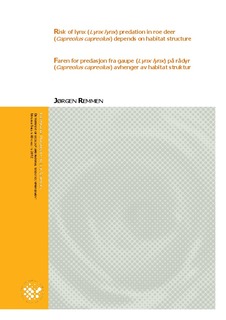Risk of lynx (Lynx lynx) predation in roe deer (Capreolus capreolus) depends on habitat structure
Master thesis
Permanent lenke
http://hdl.handle.net/11250/187091Utgivelsesdato
2012-09-14Metadata
Vis full innførselSamlinger
- Master's theses (INA) [593]
Sammendrag
Abstract
Large carnivores are recolonizing Scandinavia with possible wide reaching consequences for prey populations and ecosystems. Impacts beyond numerical effects on prey populations such as behavioral effects are still poorly understood. The idea that predators can affect their prey by just being present and inducing habitat specific fear responses is widely supported in the ecological literature; a phenomenon termed “the landscape of fear”. Habitat selection by prey animals will often result from trade-offs, in particular between food and predation risk. To understand if the concept of landscape of fear may be applied to roe deer (Capreolus capreolus) I here evaluate how the risk of being killed by lynx (Lynx lynx) differs among habitats relative to level of cover. To investigate this I compare habitat types on sites where roe deer had been killed by GPS-collared lynx with the habitat found on locations visited by GPS-collared roe deer in Hallingdal, Norway. Because the lynx is a stalking predator, I predicted that the risk for roe deer would increase with vegetation density. Accordingly, I found that roe deer in Hallingdal had a higher relative probability of getting killed by lynx in dense forest habitat. My study demonstrates that the habitat specific distribution of mortality caused by the lynx was not random and may create a landscape of fear on its main prey in Hallingdal. Dense forest structures, such as spruce seems to be riskier habitat for the roe deer to occupy, when the lynx are present, than open habitats such as clear cuts and infield. I suggest that the possible reasons for why roe deer do not avoid cover to a higher extent is most likely caused by the low chance of actually meeting a lynx at any time and associated trade-offs with access to food, avoiding human hunting and thermoregulation being given greater weight.
